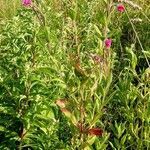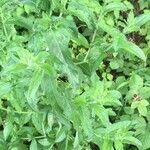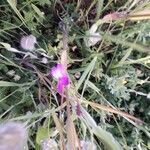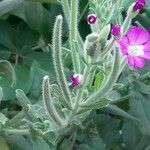Rhizomatous, usually robust herb up to 2.1 m. high, indumentum ranging from pubescent and very sparsely villous to densely villous or tomentose; capitate glandular hairs present.. Stems without imbricate scale-leaves at base.. Leaves sessile, variable, oblong or lanceolate to elliptic or sometimes ovate-elliptic or obovate-oblong, about 3–10 cm. long and 0.5–2.5 (-3.7) cm. wide, acute, sharply serrulate.. Flowers bright pink to red-purple, rarely and only casually white.. Sepals 7–10 mm. long.. Petals broadly obovate, 9.5–19 mm. long, 7–18 mm. wide.. Style 7–8 mm. long.. Stigma divided nearly or quite to base into four arcuate-recurved narrowly clavate obtuse arms 1.75–3 mm. long.. Capsules mostly 4–8.5 cm. long; pedicels 0.5–1.6 (–2) cm. long.
Rhizomatous perennial; stems erect, much branched, 5–20 dm, softly and densely villous above; lvs mostly opposite (but the bracts alternate), hairy on both sides, lanceolate or oblong and somewhat clasping, the larger ones 5–12 × 1–3 cm, sharply serrulate, with evident lateral veins; pedicels 1 cm or less; pet red-purple, 10–15 mm, shallowly notched; hypanthium shortly prolonged beyond the ovary; stigma 4-cleft; fr 5–8 cm; coma nearly white; 2n=36. Native of Eurasia and n. Afr., intr. in moist or wet soil, especially in disturbed sites, from s. Me. and s. Que. to Mass. and Md., w. to n. O., Mich., and ne. Ill.
Robust herb, 0.2-2.7 m high. Stem with long spreading pubescence; fleshy scales absent at base of plant. Leaves oblong-lanceolate, coarsely toothed, sessile, distinctly clasping at base. Flowers erect in bud. Petals 4, bright purplish rose. Stigma held above anthers at anthesis. Flowering time Dec.-Feb. Fruit a loculicidal capsule, 30-80 mm long; pedicels 2-12 mm long. Seeds oblong-obovoid, acute at base, coarsely papillose, up to 1.15 mm long, dark brown, coma up to 7 mm long.
A robust, softly hairy herb. It grows to 2 m tall and keeps growing from year to year. The leaves are opposite and can be in rings. They are oblong or sword shaped and do not have stalks. They partly clasp the stems. They are coarsely toothed and have leaf like bracts. The flowers are bright purplish-pink. They are 15-25 mm across and born in leafy racemes. The petals have notches. The stigma has 4 lobes.
Robust, perennial herb, 0.2-2.5 m high. Stems patently pubescent. Leaves subsessile, distinctly clasping base; blade narrowly obovate-oblong, 20-120 x 4-30 mm, margins coarsely toothed. Flowers: stigma deeply 4-cleft; petals 6-16 x 6-15 mm, bright purplish rose; Oct.-May. Fruit 30-80 mm long, pedicel 2-12 mm long.
Robust herb, 0·2–2·5 m. tall, the subligneous stems sometimes persistent; rhizome stout, producing thick white underground runners with very scattered cataphylls; plants more or less white-pubescent, densely covered, especially in the inflorescence, with long spreading trichomes.
Leaves 2–12 × 0·5–4 cm., mostly opposite, alternate above, oblong-lanceolate, densely hairy, acute, sessile, clasping at the base, coarsely toothed; rosette leaves longer and less hairy than later leaves; young leaves to 20 cm. long, more glabrous; petiole up to 5 cm.
Capsules 3–8 mm. long, densely villous, on pedicels 2–12 mm. long; seeds 0·9–1·15 mm. long, dark brown or even coppery, oblong-obovoid, acute at the base, coarsely papillose, the coma 5–7 mm., dull white.
Robust herb, 0.2-2.5 m high. Stems clothed with spreading pubescence. Leaves subsessile, distinctly clasping at base. Stigma deeply 4-cleft. Flowers bright purplish rose.
Softly velvety perennial to 2.5 m. Leaves lanceolate, sessile, finely toothed. Flowers solitary in upper axils, pink, stigma deeply 4-cleft.
Styles 6–10 mm. long; stigma deeply 4-lobed, held above the anthers at anthesis, lobes 1·5–2·5 mm. long.
Anthers 1·5–2 mm. long; the filaments of the longer 3·5–6 mm. long, of the shorter 2–3 mm. long.
Inflorescence with an admixture of glandular trichomes, erect in bud; flowers erect in bud.
Petals 6–16 × 6–15 mm., deeply notched, bright purplish-rose.
Floral tube 2·5–3 mm. across, c. 1–1·5 mm. deep.
Sepals 6–10× 2–2·5 mm., apiculate.
Pending.













